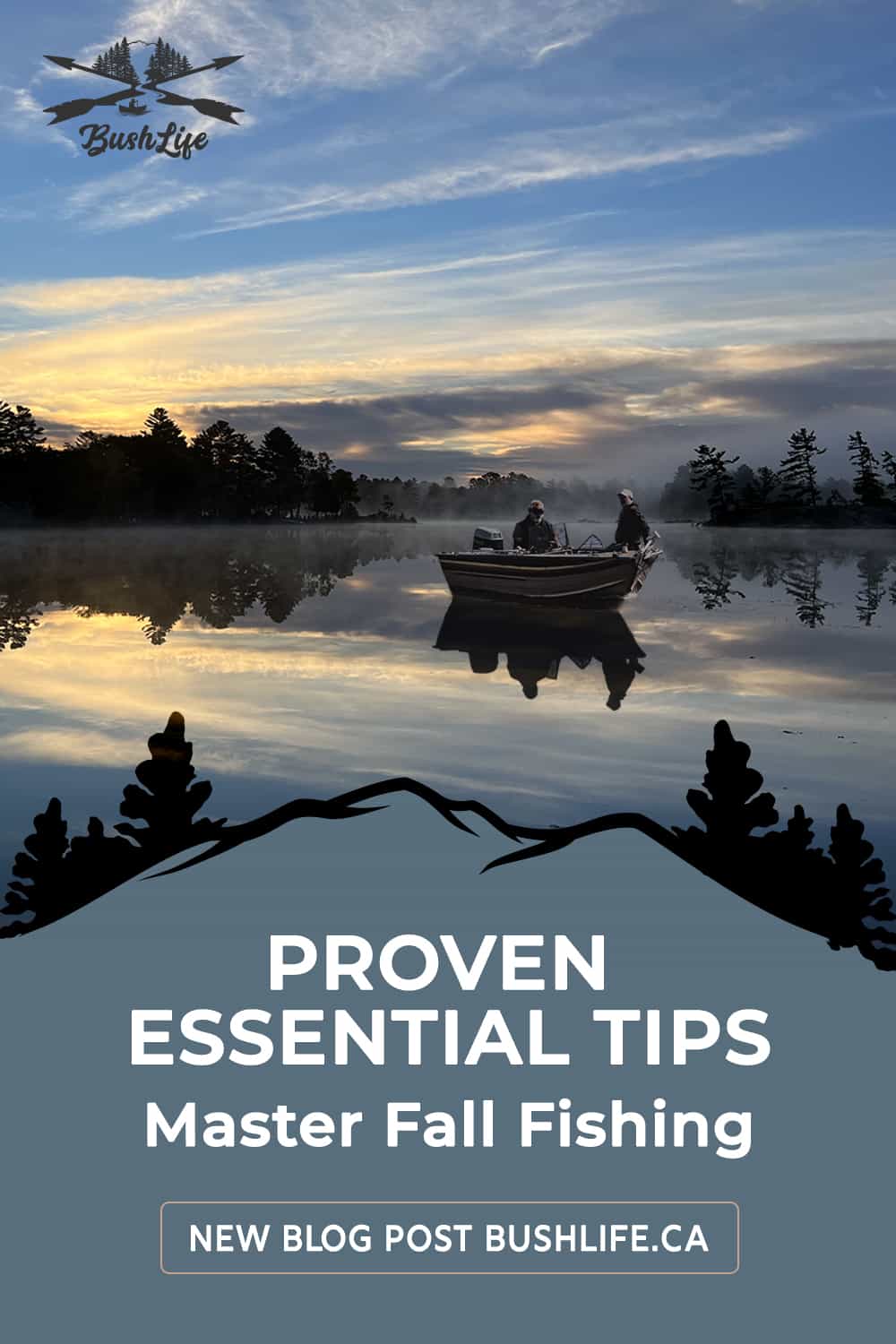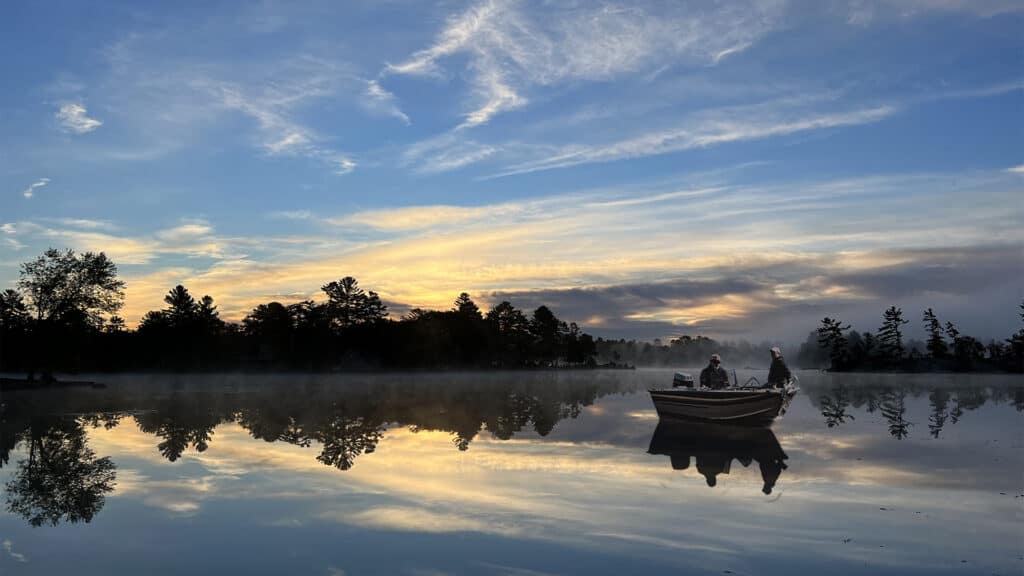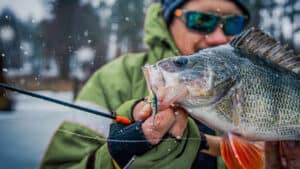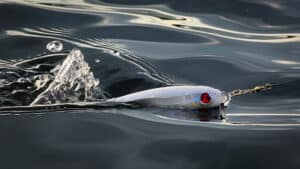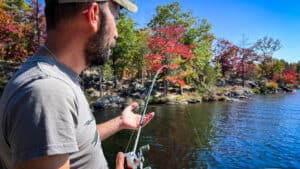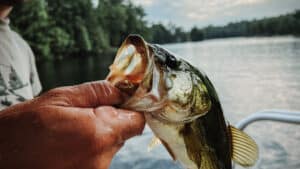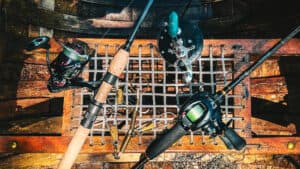Labour Day has passed, the kids are off to school, and the adults are back to a regular work schedule. For many, Labour Day marks the end of summer. Officially, autumn doesn’t set in until September 22nd. What does all this mean in terms of fall fishing? Can I still catch any fish? Should I change fishing techniques for the fall?
Let’s start by saying fishing is pretty much year-round now, and I won’t be packing away your fishing gear any time soon. Fall is the beginning of a special season – the prime musky season! Or perhaps lake trout fishing from shore. Fall is an exciting time for fishing, so keep reading, and we’ll get you on your way with some essential fishing tips and tricks.
Discloure: Posts may contain affiliate links. Purchases made through our links result in a small commission to us at no charge to you. We only recommend products that meet our brand standards based on testing and first hand use by our authors.
Fishing is All About Water Temperature!
The angler need not concern him or herself with the calendar. It’s just a date. The angler also need not concern themselves with ‘summer’ vs ‘fall’ as that differentiation is based on the amount of daylight.
September 22 is the first day of fall simply because it’s the day we have an equal amount of light and darkness in a day.
When Does Fall Fishing Start
What the angler does need to watch VERY carefully is the water temperature! To be successful at picking fishing lures, locations and techniques, you should understand the habits and movements of fish.
These very changes are all triggered by water temperature. As the days get shorter, the nights get longer and colder. The sun isn’t as powerful as it was in late July. The water temperature slowly starts to decline. By water temperature, we refer to the upper layer of a lake. Therefore, when the water drops below 21 degrees Celsius, your fall fishing season is about to start.
4 Degrees Celsius
Here is an interesting fact: Deep lakes will always hold cold water in their deeper sections- 4 degrees Celsius, to be exact, which holds almost ALL YEAR round.
In the winter, when a lake is covered by ice, the upper layer is also 4 degrees. As the ice melts in the spring, the sun warms up the upper layer, peaking sometime in August or September. This process then reverses until the lake’s surface freezes again in the winter.
Water Layers Don’t Mix!
Cold water is more dense than warm water. Based on this principle, the warmer upper layer of lake water will float on top of the colder, dense water below. This is VERY important because it means the two layers don’t mix. Well, sort of. They mix a little bit where they meet, which is called the thermocline.
By now, you must be bored and wondering why you are reading this. Simple, let’s say you were fishing for trout in the summer from shore – it’s safe to say that you would be wasting your time. Trout needs the cold water to survive. Technically, they may occasionally come up to raid some baitfish, but not often and not for too long. To fish them properly, you need to find that thermocline and set up your fishing lure to dive deep enough.
So, let’s get back to fall fishing. As the upper layer’s temperature drops, the deep, cold sections will eventually start to mix. At some point, the entire lake will be around 4 degrees, and the cold water species, like lake trout, will have access to all the waters in the lake. It will also force all the fish to move around, which we’ll cover later.
A Brief on Oxygen
Yes, I know – you want to be a better fisherman and not a marine biologist, so I’ll make it snappy. Oxygen is introduced into water by wind/wave action. That churning on the surface drives the oxygen into a specific water body. The trouble is during warmer months, when the layers don’t mix, fish locked in the colder zones for temperature needs are using up whatever stored oxygen is in the water. By now, that is generally running out. When the upper layer cools enough to mix with the water below, oxygen is then re-introduced into the entire lake.
Fish Movement in the Water
Now that we understand what is happening with temperature and oxygen, we must look at how it affects where the fish naturally hang out or move. It also helps understand their behaviours, so let’s look at some specifics for the coveted fish below.
Fall Fishing for Muskie (Musky, Muskellunge)
In Ontario, the prime muskie season is Labour Day to snowfall. These fish are trying to fatten up for the winter and are eating voraciously during this time. It is particularly true (at least in my area) when the water starts hitting 15 degrees Celsius. It almost activates them. Muskies will come out more and raid weed beds, shoals and shallows for food.
The way I was taught Muskie fishing by my grandfather was to move around islands, shoals and rocks. You then toss the largest surface plug you could find. Cast your fishing lure and work with a jerk and rest motion, cranking the reel in between to take up the slack in the fishing line. We used to use a 6″ plug, which, in hindsight, is pretty small. You’ll see a photo of an 8″ below. The most common lure for muskies is a big bucktail – start with a black one with a gold or silver spinner.

I decided to go after the old muskies this season and bought quite the rod and reel, along with some shiny new fishing tackle. The problem with muskie fishing is the size and weight of lures. A spinnerbait, for example, would be around 7″ long and 6″ wide and weigh around 2.5 oz. Your bass rod may only handle 3/4 of an oz. Muskie fishing requires a dedicated setup!
Just be warned, the musky is known as the fish of 10,000 casts! It’s a commitment of money (gear) and TIME. But if you land a 4-foot monster in the boat, well, let’s just say that bass fishing may never be the same:)
Fall Fishing for Walleye (Pickerel)
Unlike bass, walleye is generally a much harder fish to catch, regardless of the season. According to MNR reports from their netting/identifying activities, walleye are definitely in the lower count levels compared to other fish in almost every report. Nonetheless, it’s an amazing fish to eat and highly sought after.
During the summer, I troll with a homemade rubber worm rig. On this rig are a few beads (usually yellow) before and after a spinner on a mono fishing line. The key is to troll dead slowly as they get lazy in the hotter water. Oddly, I’ve used the same system in the fall with great success for decades.
Sometime in October comes a pivot point where the walleye head for the deep. You’ll know when this transition happens, as what worked before no longer does.
To fish the deep for walleye in the fall, find a drop-off where you can anchor over 50-60 ft deep water and drop a live minnow on a simple hook. Yes, it’s boring, but it works! This method has always carried my walleye fishing right into November when it was time to take the boat out of the water.
Further Reading: A Promising Pike Fishing Rod = More Fish in the Boat
Fall Fishing for Bass
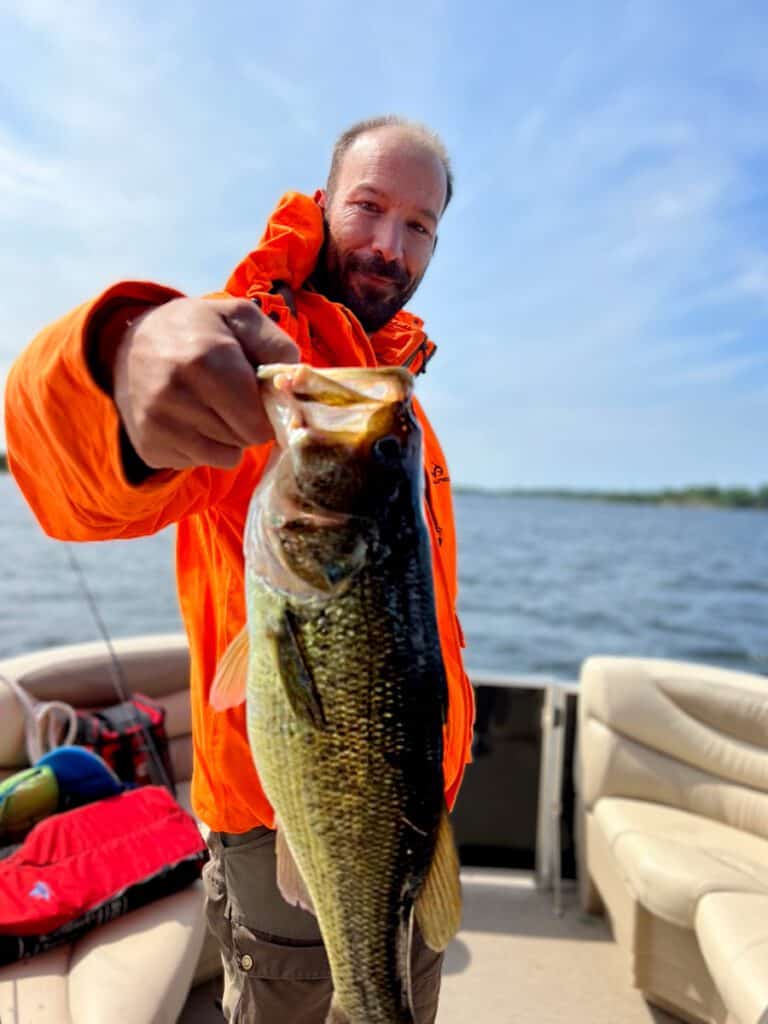
As temperatures drop, the baitfish leave and the Bass follow. In the fall, Bass will head towards the top or bottom of the water column – this is also when your focus should leave the middle. At first, the focus should be more toward the top as the baitfish seek warmer, shallow water. An excellent topwater lure for Bass fishing is the good old buzz bait.
I like running some traditional lures like the Hula Popper or Jitterbug. It’s my choice for a “popper” kind of fishing lure. But going back a step, I LOVE the buzz bait the most and have done well with it, particularly in yellow. Remember one thing about buzz baits, while you can always try them, they are THE go-to anytime it’s raining. Try to get them as close to shore as you can, it’s where my strikes are happening most – shores of islands.
Update: Our new post, Choosing the Best Bass Fishing Lures: A Beginner’s Guide has a lot of info on lure selection, including some of our new favourite topwater lures!
When in really weedy areas, including lily pads – a frog is outstanding at getting through. Here’s a photo of the 6th Sense Frog that I use:
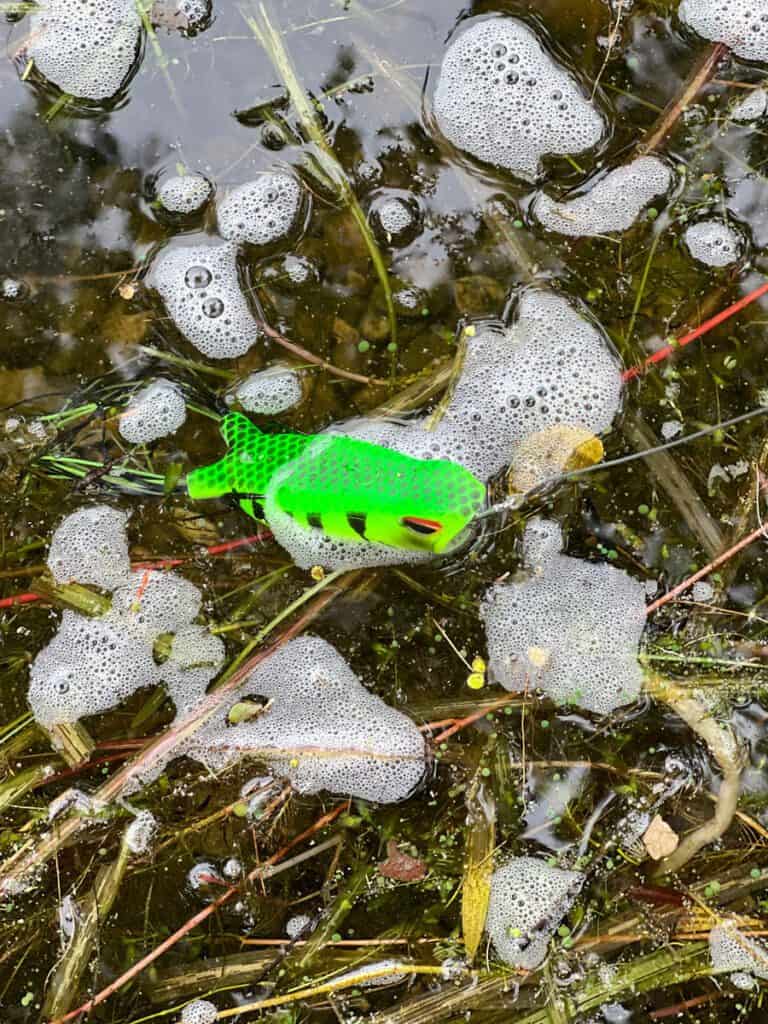
I’ve been bouncing frogs over lily pads for the last few days and can’t seem to get them stuck on anything. The rule of thumb for using a frog is – when nothing else will get into the cover you are fishing, it’s time to use a frog. You must understand this means getting into the cover and not beside it. All your lures can get beside the cover. Now, try your luck getting right in there with a frog.
Crank vs Jerk Baits
There’s nothing like the excitement of topwater strikes. However, don’t forget the timeless crankbaits and jerkbaits. During the fall fishing season, there comes a point when the crankbait should be replaced with a jerkbait.
If the Bass in your area are indeed eating up vs down, the shallower action of a jerk bait will get your lure into the hot zone. Some lakes can also get a little clearer as the cold sets in. It’s another cue to put the jerk bait into service. Jerkbaits are based more on flash than rattle. If one’s not working, try the other, and if it’s the right choice, you will see a dramatic difference in the number of bites you get.
When it comes to lures, remember you are just trying to mimic the local baitfish. Keep that in mind when picking shapes and colours. Even between a jerk vs crankbait, the idea is to copy the type of fish natively present in your waterbody. Jerkbaits are shaped more like minnows, shad and so on. Crankbaits will cover bluegill and perch shapes. One of our favourite cranks is the Megabass Deep-X 200.
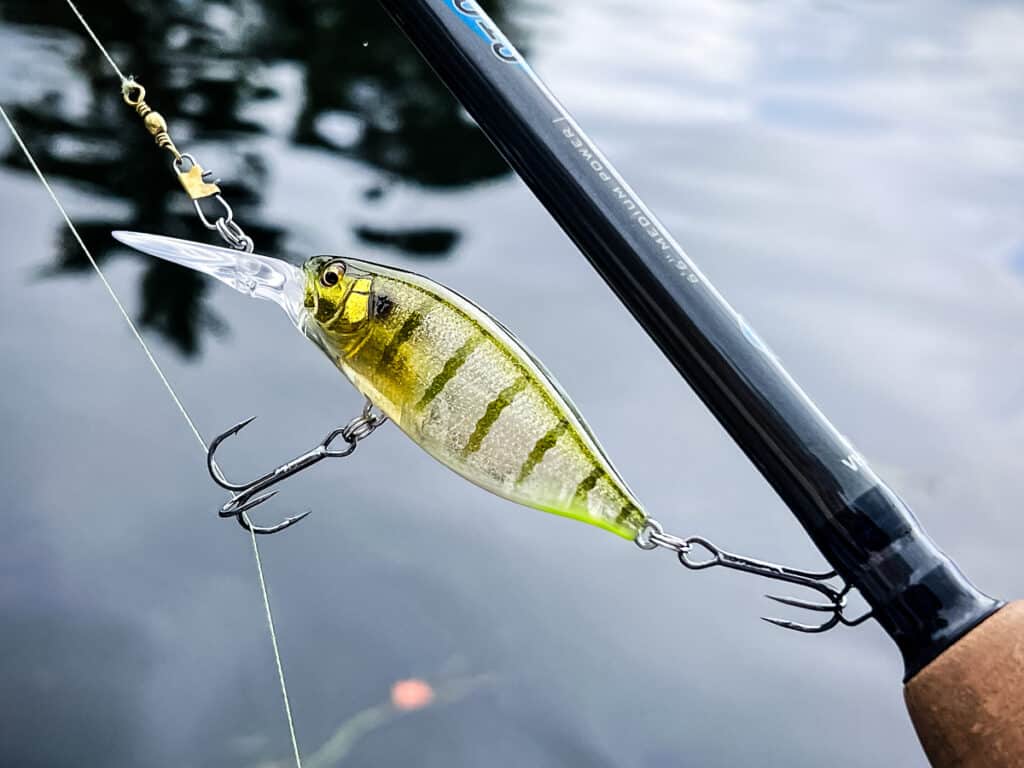
Basics Don’t Change
Fall is when you will see all the anglers spread out and working the shores and islands. It’s that pivot point when all the boats no longer sit on top of each other over some hole. It’s time to spread out and start chasing the Bass the same way they chase baitfish.
Don’t forget the basics, which is to work cover: weed beds, brush piles, rock, docks, etc. Areas with lots of currents are always another good bet. The fishing fundamentals haven’t changed. All we need to do is adjust for fall patterns.
Fall Fishing for Lake Trout
Sorry folks, my fishing tips end with the trout – it’s not a fish I go after, and I can’t speak to it. The good news is as the water gets cold, the trout come up from the deep, which opens up the species for anyone who doesn’t own a boat, as it’s the only time of year you’ll get them from shore. It also removes the need to drop lures super deep or try to guess where the thermocline is. If you want to take up trout fishing for the first time, the fall fishing season is the perfect time to start!
Concluding Fall Fishing
In conclusion, fall fishing can be an exciting time for anglers, with the changing water temperature and oxygen levels affecting fish movements and behaviours. Whether targeting the elusive musky or going after lake trout from shore, understanding the habits and movements of fish can help you become a more successful angler. So, don’t pack away your fishing gear just yet – grab your rod and reel and head out to enjoy the prime fall fishing season!
Comment below if you think we missed anything. A little parting tip: as things transition, there can be fishing lulls here and there. Work through them – they will pass, and most importantly, don’t give up!
Bookmark this post on Pinterest for future reference!
